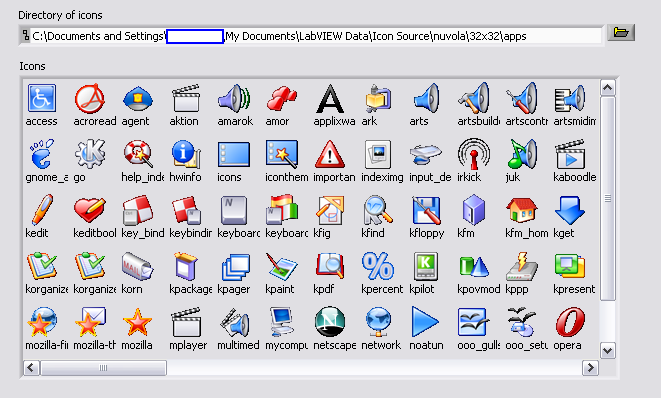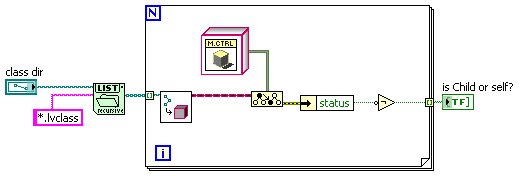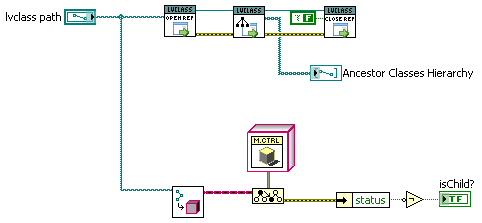-
Posts
1,213 -
Joined
-
Last visited
-
Days Won
49
Content Type
Profiles
Forums
Downloads
Gallery
Everything posted by Francois Normandin
-

How to show many different ICONs in control
Francois Normandin replied to Angle's topic in User Interface
Hi, I'd use the 2D Picture control and play with text positioning. Here's a start. icons.vi (LV 8.5) -

Web Services in LV2009SP1
Francois Normandin replied to John Lokanis's topic in Remote Control, Monitoring and the Internet
I'm waiting to attend your session before I jump on the train... Don't give up yet! -
Digital is for two states: ON-OFF (binary) Analog is for signals. Think digital if you want to control a valve or a relay (digital output) or to sense if an on-off state (digital input) like an interlock or a limit switch. Think analog if you want to generate a signal (analog output) or read a sensor (analog input). Now ask yourself what are the sensors and controls you want to activate/read on your tank. Classify them as analog or digital, inputs or outputs. Then see which lines are available on your 6008 to do this. Select one line for each of your inputs/outputs, wire them and use the DAQ assitant to create them in your VI. Of course, look also at the link Minh Pham put in his last reply... good luck
-
I must be a misfit because I love to touch my food with my hands.
-
Not at all. I just wanted to add some background noise... Something I've done a lot lately. LAVA is by no mean a unique reference...
-
Is this what you mean? I've got one LabVIEW book and I can't remember when was the last time I found something in there I didn't know. Books tend to start off with the beginning and well, stop whenever the topics get too particular or advanced. These books are probably as good as any for someone getting started with LabVIEW, but for veterans like you, it seems to me that a book you'd get interested in wouldn't sell much because of the reduced audience. By the time books are published, you'll probably have gotten all the good juicy new stuff from reading LAVA assiduously.
-

Inheritance hierarchy
Francois Normandin replied to Francois Normandin's topic in Object-Oriented Programming
Great, now I can upgrade the LVClass API in CR to its latest version without infringing some taboo. -

Dragging and dropping front panel items while vi is running
Francois Normandin replied to Suvin's topic in User Interface
It's definitely doable. Look at this video. -
Just follow the link at the bottom of the first post to the download section.
- 54 replies
-
- alignement
- dialog
-
(and 3 more)
Tagged with:
-

watch VI from web
Francois Normandin replied to v_pan's topic in Remote Control, Monitoring and the Internet
Actually, that happens sometimes when you create a web server on your home computer. My ISP (Montreal) blocks outgoing data on port 80 to prevent me from using it as a web server (without paying big bucks for a commercial access). The workaround is to configure the web server to use a different port (http://www.example:1000) that is not blocked. I guess that's what he's talking about. -
That's because our leaders are elected to delegate work to their constituents.
-

Read Class hierarchy at runtime
Francois Normandin replied to Jon Kokott's topic in Object-Oriented Programming
Yes, this is expected behavior. Ancestors cannot be children of your intial class. If C is child of B, and B is child of A, then: 1- Wiring A.lvclass as input will give {A.lvclass} (self -> no ancestor class except LabVIEW Object) 2- Wiring B.lvclass as input will give {B.lvclass ; A.lvclass} (self + parent "A") 3- Wiring C.lvclass as input will give {C.lvclass; B.lvclass ; A.lvclass} (self + parent "B" + parent of B ) etc. To find Child classes, you can't ask the parent class "Who are your children?". You need to list the directory where your classes reside at runtime and typecast to see if they match the class type of the parent. -

Read Class hierarchy at runtime
Francois Normandin replied to Jon Kokott's topic in Object-Oriented Programming
Hi Jon, You'll have to separate this in two approaches: ancestors and descendants. For ancestors, there is a private method for getting the ancestor class. Running it recursively will get you all the ancestors. You can cut the chase by installing this API. There are methods found in the installed palette for doing what you want. For descendants, the parent doesn't have any record if a class is its descendant. So you've got to typecast the potential child to its alleged parent class and see if it throws you an error. -

abort running loop
Francois Normandin replied to wallage's topic in Application Design & Architecture
It should never take more than 400ms to stop this VI, unless you have the "Lock Front Panel" checked in the Event Edition screen for OK button, thus preventing any other buttons to be pushed until the event frame completes. -
If you expand on what Yair posted, you can get it more easily than what you've described. (Inverse row/column indicator depending on the orientation of your cluster array.)
-
It's an IP Board issue. I think Tomi Malla noticed it first on his own posts...
-
Link is broken because of weird bug with links that contain "expression": Here is the unlinked path: "expressionflow.com/2007/10/01/labview-queued-state-machine-architecture" (BTW, that's an excellent tutorial to keep at hand for newbies.)
-

Color detection in IMAQ Vision
Francois Normandin replied to lovemachinez's topic in Machine Vision and Imaging
If you've got the original image, don't try to convert it back. Instead, make a copy and use that copy to extract a plane and convert it to binary. You can discard the copy to regain memory space when done. -

shift register in sequence structure
Francois Normandin replied to psychomanu's topic in Development Environment (IDE)
You can do it on your own with templates you've customized for your own particular needs. One known example is the JKI State Machine. I'm not sure you want to add it to the Structure palette, though it's possible. NI provides such templates in the "New VI Dialog", not as drop-ins VI in the palette. I usually keep my templates in user.lib since it's easily exportable from version to version. -
Is that even legal on March 31st?
-
The content is all in case 42.
-
-
Nice one! You should have kept this for April 1st and provided a scripting tool as an add-on to jcarmody's RCF Case Structure plugin!
-

Designing a Control System
Francois Normandin replied to bradjb911's topic in Application Design & Architecture
Hi Brad, take a look at some example of Enum State Machine. Here on or NI examples.







